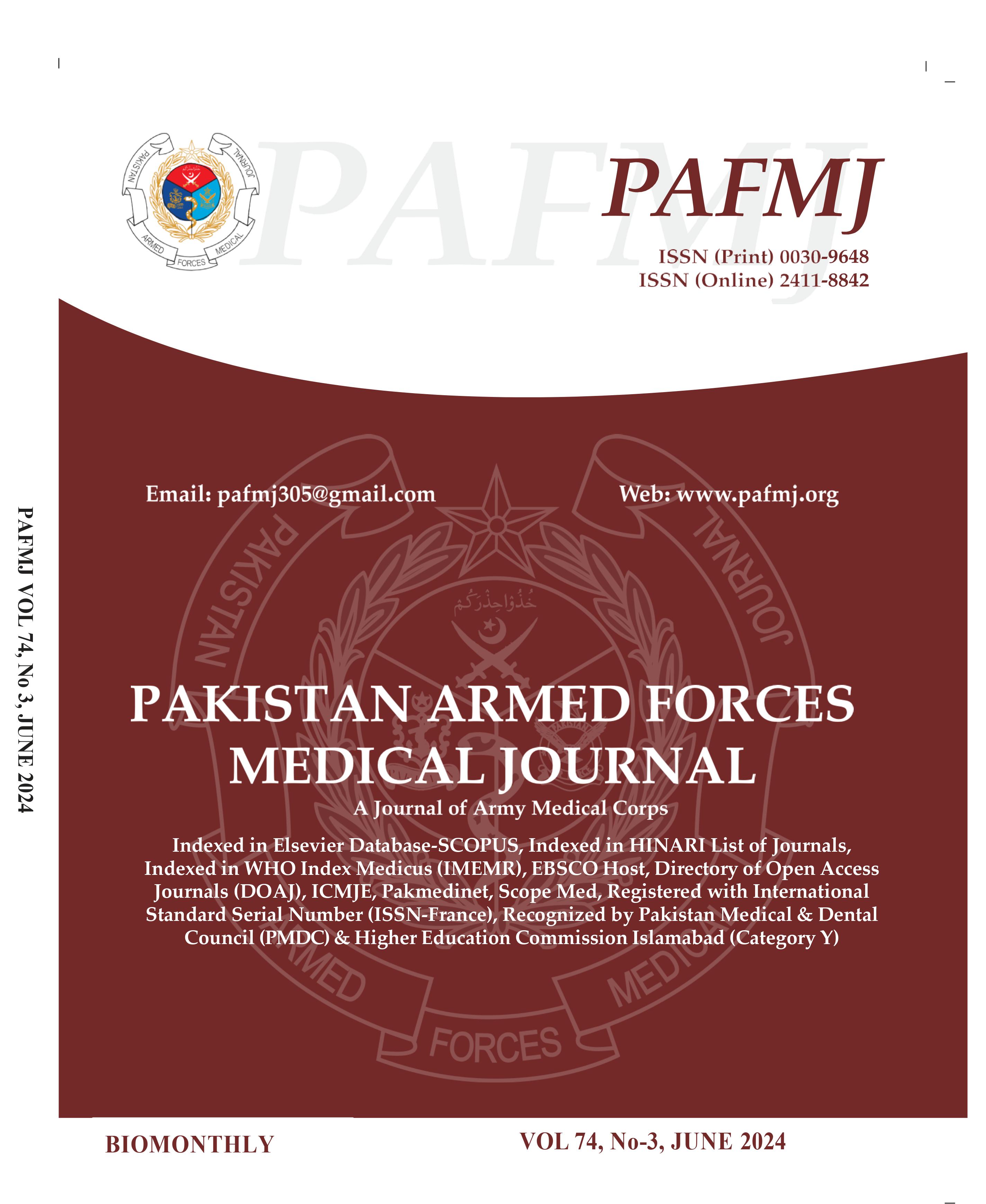Relationship of Train-of-Four (Neuromuscular Monitoring) With Head Lift for Five Seconds During Emergence From General Anesthesia
DOI:
https://doi.org/10.51253/pafmj.v74i3.8772Keywords:
Nerve Stimulation, Neuromuscular, Neurological Manifestations, Signs and Symptoms, Train-of-four ratioAbstract
Objective: To establish relationship between train-of-four ratio and clinical signs including head lift during emergence from general anesthesia.
Study Design: Cross Sectional Study.
Place and Duration of Study: Combined Military Hospital, Rawalpindi Pakistan, from Apr to Sep 2021.
Methodology: A total of 93 patients with age range 18–60 years and ASA (American society of Anesthesiologist’s) physical Status I or II undergoing an elective procedure lasting more than 60 minutes under general anesthesia were included in study. Train-of-four ratio was calculated using a nerve stimulator at the time of extubation followed by the appearance of each clinical sign.
Results: Of 93 patients 63(67.7%) were males while 30(32.2%) were females with mean age 35.6±12.5 years. 77(82.7%) patients were graded as ASA-I and 16(17.2%) were graded as ASA-II. The mean duration of surgery was 83.5±8.3 mins however the mean TOFR was 0.35±1.1. At the appearance of each clinical sign mean TOFR was calculated and recorded. The results showed significant relationship between clinical signs (sustained head lift, ability to retain tongue depressor, hand grip 60% of control and ability to cough) and Train-of-four ratio.
Conclusion: There is a significant relationship between clinical signs (sustained head lift, ability to retain tongue depressor, hand grip 60% of control and ability to cough) and Train-of-four ratio.
Downloads
References
Hooda B, Unnithan RR, Sud S, Dwivedi D, Dudeja P. Do clinical signs of recovery from neuromuscular blockade compare reliably with objective parameters of train-of-four and double burst stimulation: An observational single-center study. Indian Anaesth Forum 2020; 21(2): 134-139.
https://.doi.org/10.4103/TheIAForum.TheIAForum_17_20
Murphy G. Neuromuscular Monitoring in the Perioperative Period. Anesth Analg 2018; 126(2): 464-468.
https://www.doi.org/10.1213/ANE.0000000000002387
Debaene B, Frasca D, Moreillon F, D’Hollander A. 100 Hz-5 s tetanic stimulation to illustrate the presence of “residual paralysis” co-existing with accelerometric 0.90 train-of-four ratio—A proof-of-concept study. Anaesth Crit Care Pain Med 2021; 40(4): 100903.
https://doi.org/10.1016/j.accpm.2021.100903
Dullenkopf A, Horn K, Steurer M, Hess F, Welter J. Placement of TOF-Cuff® on the lower leg for neuromuscular and blood pressure monitoring during anesthetic induction for shoulder surgeries. J Anesth 2019; 34(1): 79-85.
https://doi.org/10.1007/s00540-019-02712-7
Dubois P, Mitchell J, Regnier M, Passeraub P, Moreillon F, d’Hollander A. The interest of 100 versus 200 Hz tetanic stimulations to quantify low levels of residual neuromuscular blockade with mechanomyography: a pilot study. J Clin Monit Comput 2022; 36: 1131–1137
https://doi.org/10.1007/s10877-021-00745-6
Saitoh Y, Nakazawa K, Makita K, Tanaka H, Amaha K. Evaluation of Residual Neuromuscular Block Using Train-of-Four and Double Burst Stimulation at the Index Finger. Anesth Analg 1997; 84(6): 1354-1358.
Azizoğlu M, Özdemir L. Quantitative Neuromuscular Monitoring With Train-of-Four Ratio During Elective Surgery: A Prospective, Observational Study. J. Patient Saf 2021; 17(5): 352-357.
https://doi.org/10.1097/PTS.0000000000000874
Naguib M, Brull S, Kopman A, Hunter J, Fülesdi B, Arkes H, et al. Consensus Statement on Perioperative Use of Neuromuscular Monitoring. Anesth Analg 2018; 127(1): 71-80.
https://doin.org/ 10.1213/ANE.0000000000002670
Bowdle A, Bussey L, Michaelsen K, Jelacic S, Nair B, Togashi K, et al. Counting train-of-four twitch response: comparison of palpation to mechanomyography, acceleromyography, and electromyography. Br J Anaesth 2020; 124(6): 712-717.
https://doi.org/10.1016/j.bja.2020.02.022
Motamed C, Demiri M, Colegrave N. Comparison of Train-of-four Measurements with Kinemyography NMT DATEX and Accelerography TOFscan. J Med Sci 2021; 9(2): 21.
https://doi.org/10.3390/medsci9020021
Wardhana A, Kurniawaty J, Uyun Y. Optimised reversal without train-of-four monitoring versus reversal using quantitative train-of-four monitoring: An equivalence study. Indian J Anaesth 2019; 63(5): 361.
http://doi.org/ 10.4103/ija.IJA_94_19
Lee W. The latest trend in neuromuscular monitoring: return of the electromyography. Anesth Pain Med 2021; 16(2): 133-137. https://doi.org/10.17085%2Fapm.21014
Blobner M, Hunter J, Meistelman C, Hoeft A, Hollmann M, Kirmeier E, et al. Use of a train-of-four ratio of 0.95 versus 0.9 for tracheal extubation: an exploratory analysis of POPULAR data. Br J Anaesth 2020; 124(1): 63-72.
https://doi.org/10.1016/j.bja.2019.08.023
Patrocínio M, Shay D, Rudolph M, Santer P, Grabitz S, Xu X, et al. Residual Neuromuscular Block Prediction Score Versus Train-of-Four Ratio and Respiratory Outcomes: A Retrospective Cohort Study. Anesth Analg 2021; 133(3): 610-619. https://doi.org/10.1213/ANE.0000000000005363
Yang L, Yang D, Liu C, Zuo Y. Application of Neuromuscular Monitoring in Pediatric Anesthesia: A Survey in China. J. Perianesth. Nurs 2020; 35(6): 658-660.e1.
https://doi.org/10.1016/j.jopan.2020.03.001
Betz M, Aguirre J, Schubert M, Götschi T, Huber B, Schüpbach R, et al. Hand or foot train-of-four tests and surgical site muscle relaxation assessed with multiple motor evoked potentials. Eur J Anaesthesiol 2020; 38(8): 872-879.
https://doi.org/10.1097/EJA.0000000000001398
Lin X, Yong Y, Mok U, Ruban P, Wong P. Survey of neuromuscular monitoring and assessment of postoperative residual neuromuscular block in a postoperative anaesthetic care unit. Singapore Med J 2020; 61(12): 591-597.
https://doi.org/10.11622%2Fsmedj.2019118
Thilen S, Weigel W. Neuromuscular Blockade Monitoring. Anesthesiol Clin 2021; 39(3): 457-476.
Downloads
Published
Issue
Section
License
Copyright (c) 2024 Syed Zeeshan Haider, Muhammad Rashid Iqbal, Muhammad Adil

This work is licensed under a Creative Commons Attribution-NonCommercial 4.0 International License.















